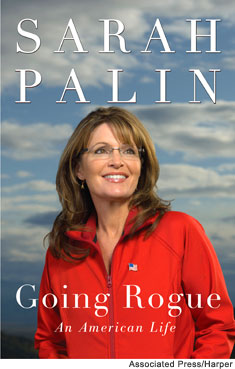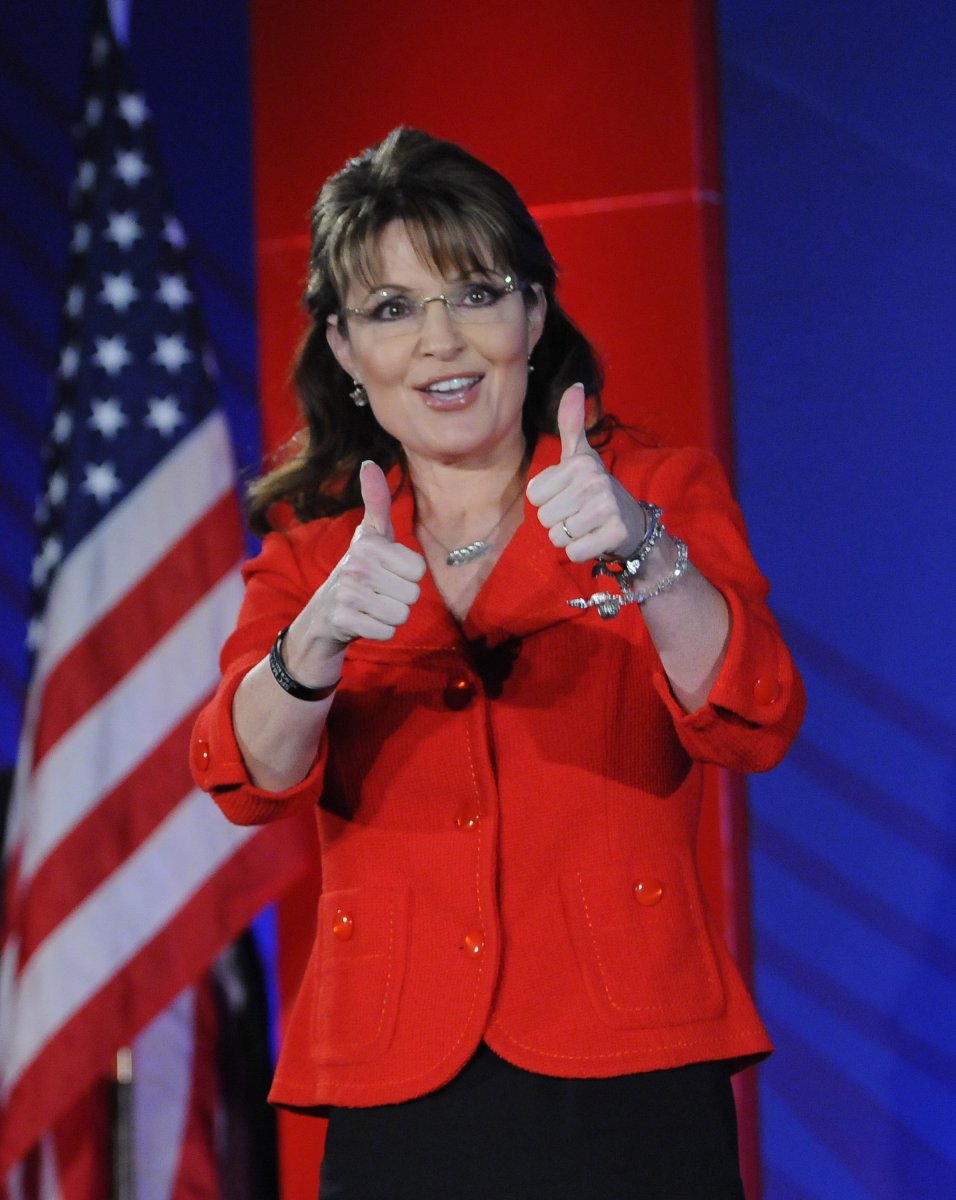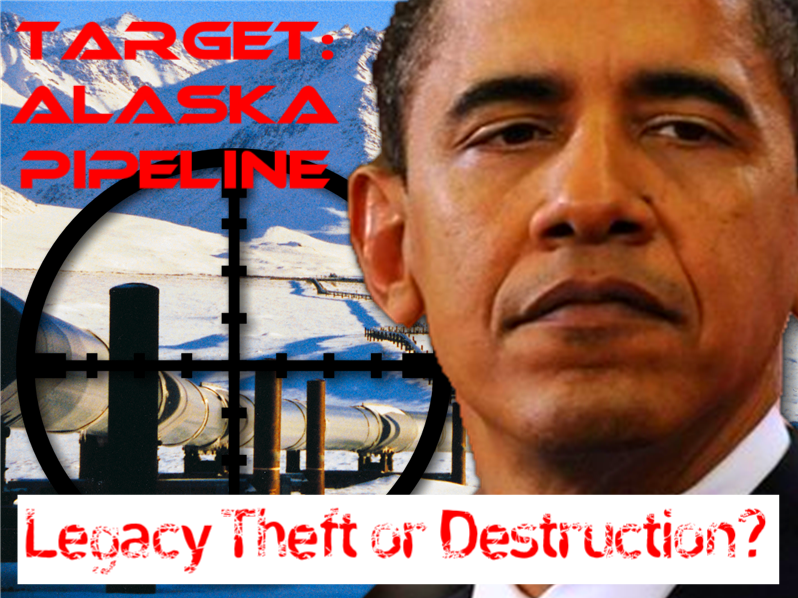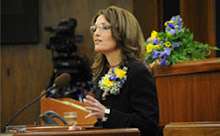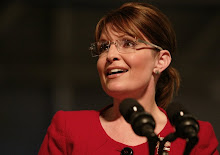On September 29th, I posted an article called "Public School Library Propagates Falsehood that Governor Palin Banned Books." (See video at the end.)
To recap:
I was walking on my way to the weight room this evening when I stopped dead in my tracks after taking a few steps past the library. I backed up and took in the display in the window, which includes various books, quotes, and poetry about reading and book banning. Only one person's picture is a part of the display--and that person is Governor Palin. It was included in an old article called "Sarah Palin, aspiring book banner?" which was published in the LA Times a year ago. That article makes up a homemade poster that says, "Sarah Palin + Banned Books = Censorship."
Listen, I'm not talking about a local area library. I'm talking about a public school library, where they use this week to demonize Palin as the enemy of free thought, reading, and exploration. Nevermind the plethora of information out there that she never sought to ban books but had asked a general question of a librarian to discover how she would deal with censorship. Nevermind the numerous times Governor Palin has herself stated she never sought to ban books. And nevermind the fact that some of the books on the list, like Harry Potter, hadn't even been published yet! No, facts aren't important.
[...]
On the left and right of the display in the library window is the poem "Manifesto" by author, Ellen Hopkins. In the poem, Hopkins blasts "zealots, biggots, and false patriots," for their desire to censor. This poem is the official poem of this year's Banned Books Week--and Governor Palin's picture is the centerpiece!
What gives them the right to place this attack in the library window? Who approved the display--or who overlooked it? Am I the only person who walked by and saw it? What impression does it give our children? What impact will this have on their vote in a few years? I am livid, as I should be. This is absolutely unacceptable behavior.
[...]
My approach tomorrow? I will go into the library with the facts and present them respectfully. I will ask that Governor Palin's picture and the article be removed. If that is denied, I will request they hang another article next to it--which I will graciously provide--that refutes the falsehoods. If I do not get anywhere with the librarian, well, I'll go to the next level. It is my hope that my talk with the librarian will suffice, but we'll see what happens.
So what has happened? Many of you have contacted me to find out what became of the situation. Time has transpired, but please know that I haven't been sitting around for the last couple weeks. I have actually been very much in the thick of things, battling this situation and standing up for the truth--the truth about Governor Palin, yes, but more importantly, truth for our kids who deserve as much in an educational setting.
So let me take you step by step through this situation.
Tuesday evening, September 29th:
I notice the display.
Wednesday morning, September 30th:
First thing in the morning, I enter the school library with articles that state the truth about the book banning accusation that surfaced during the 2008 campaign. I respectfully address the falsehood. The librarian acknowledges that Governor Palin never banned books, but states that she believes Palin wanted to ban books. Therefore, she feels justified in hanging a poster, which she admits she personally made, that links Governor Palin to banning books. She, too, is respectful, but she refuses to remove Governor Palin from the display. Even after over 20 minutes of conversation, she will not budge--only says she'll do more research. During the conversation I suggest putting up, alongside her display, the articles that I have that state the facts.
Wednesday afternoon:
A co-worker comes to see me because the librarian emailed her a link to the blog I wrote about the display. (Apparently the librarian came upon it in her research.) We engage in conversation regarding the issue.
Wednesday, later in the afternoon:
I haven't heard more from the librarian, and I seek out the principal. I ask him if we can have a meeting about the issue, and I fill him in briefly. I explain that Governor Palin's picture was in the midst of a display with a poem calling out "bigots, zealots, and false patriots." I also tell him the banned books lie was dealt with a year ago. He cuts me off, says a meeting isn't necessary, and that he will take the display down "right now." He tells me he has not seen the display. At this point, I think the falsehood is dealt with and all will be well--responsible action taken.
Wednesday, before the end of the day:
I receive an email from the principal stating he has seen the display, has talked to the librarian, and if I need to talk to him further, give him a call. At this point I realize he has not directed the librarian to remove Governor Palin from the display. I call his office, but he is in a meeting. I stop in to see him before I leave work, but he has left. I go by the library--and there the dishonest display remains. (How many students have been lied to by now?)
Thursday morning:
I drop by the principal's office to talk to him. I spend about a half hour discussing the issue with him. I explain that I didn't want to have to come to him, that I was hoping the librarian and I could have resolved it. He has a copy of the article that she posted and says she told him that because Governor Palin is "provocative," she wanted to use her to draw the kids in. I explain that as an educational institution, it is absolutely necessary that we draw kids in with the truth, not lies that amount to defamation. I also say that the librarian has admitted that Governor Palin never banned books, yet is insisting on keeping the display up. I use the example that President Obama is also provocative and that there are many opinions of him, for example the birth certificate issue, but that to put up a display that said, "President Obama + No Birth Certificate = Illegal Alien" or something like that would not only be unfair to him, but it would be unfair to our students. I point out that this is clearly an attempt to demonize Governor Palin and to indoctrinate our students--and neither has a place in a school. He doesn't say much throughout our conversation, just looks at me and allows me to speak. I reiterate that Governor Palin never, ever asked for books to be banned, and that it is on record that no books were ever banned from the Wasilla Library. I have the evidence with me. I mention also that at this point the display has been up too long, hundreds of students have seen it, and the responsible thing would now be to take down the display and post the truth. If we are going to be in the business of educating, it's important to use facts--and when we mess up, just correct it. It's that simple. As the meeting is winding down, he eventually says, "I will speak to her." When I ask if he will ask her to remove the misinformation about Governor Palin from the display, he simply repeats, "I will speak to her." When I ask, "Will you let me know the decision about the display?" he answers, "I will speak to her." I then say, "Well then, I'll follow up," and I leave his office.
Thursday, after school ended and most staff had left:
I walk by the library to see if the display is as it has been. It is unchanged.
Friday morning:
I email the principal to state that the display was still up as of Thursday evening, and that since this is the last day of Banned Books Week, the responsible thing to do in our quest for teaching young adults the truth is to put up a display that states the fact that Governor Palin never banned books. I write that our children deserve as much and that it is our responsibility not to cause even one of them to be misled. I receive no response.
Friday, well after school had ended:
I walk by the library and see that the display is down. I pretty much expected this since Banned Books Week is over. Another display for Day of the Dead is up. I then decide to go to the Administrative Suite to see if the superintendent is still there. He is. I explain the situation to him--and he appears very supportive. He had not been aware of the situation and seems concerned that something of this nature would be displayed in our school. I express that it is not only flat out dishonest, but it is unfair to the students we are committed to educating. He is especially interested in the fact that the librarian has acknowledged that she knows Governor Palin never banned books. I state that the responsible thing to do now is to put the truth up, as we have displayed a lie to hundreds of students in the past week in an attempt to demonize one person and advance a political agenda. My point to him is this: if that wasn't the motivation, why wouldn't she put up someone's picture who actually had banned books? I tell him that I want the truth to be displayed where the lie was for all our students to see, that this is the only responsible action. I state that the only thing that would keep someone from doing so is pride. He suggests that what I'm asking is reasonable but that he wants himself, the principal, librarian, and me to meet. I leave his office feeling good about the meeting and believing we will do the educationally responsible--and moral--thing.
Monday, October 5th:
At the end of the day, I email the superintendent about where things stand in terms of setting up a meeting about displaying the facts. I state that I would really like to get this out of the way.
Tuesday:
I pass the superintendent in the hall in the morning. He states that we will have a meeting and thanks me for the reminder email.
Wednesday and Thursday:
I receive emails from the principal and his secretary about meeting with him. These emails amount to: I state that we have already met privately and that I would like to have the meeting the superintendent and I discussed--with everyone present. I send emails to all involved stating again that I'd like to do the responsible thing and correct the wrong by displaying the truth for our students. I email my times of availability to meet during the day or after school. I receive an email from the principal's secretary stating he can meet eight days later. I respond by stating that date is too far away and perhaps something will open up sooner. The principal emails that it is very difficult to arrange a meeting that fits everyone's schedule and would let me know when something opens up. I send him a "thank you" email.
Friday:
At the end of the day, as I am co-teaching a class, I receive a phone call from the principal's secretary stating the superintendent, principal, and librarian are waiting for me to attend the meeting. Apparently there was some miscommunication because I had never been notified that the meeting was arranged. I leave the class in the hands of the co-teacher and go to the meeting.
Meeting:
I am asked to share my concern again. The superintendent expresses his viewpoint, which is that this should have been taken care of when I first went to the librarian. In other words, the display should have simply been taken down, as I came respectfully and directly to the librarian. The librarian states that she wanted to draw the kids' attention to Banned Books Week and Governor Palin could do that. When asked if it worked, she says that it did work, that many students came in to ask questions and to borrow books. There is a lot of discussion, which boils down to my stating that it is dangerous to use people and lies to shape the thinking of children. The superintendent voices his concern about the display and states that it should have come down, but says that he isn't sure he wants to become like a newspaper and retract what was up. I maintain that as educators this is the right thing to do. After all, the librarian herself said that many students took note of the display and discussed it. I express again that using only one person's picture--and someone who never banned even one book--to be the poster child of a display about "bigots, zealots, and false patriots" is unacceptable. I say that the librarian is entitled to think Governor Palin wanted to ban books, but she is not entitled to take that thought to the next level and present it as fact, which is exactly what a poster that says "Sarah Palin + Banned Books = Censorship" and an article about it does. I also state that if she thinks the governor wanted to ban books, then maybe she should wait until "People I Think Wanted to Ban Books Week" to put her in the midst of a display! When the superintendent asks the principal what he feels about the retraction display I am requesting, the principal doesn't commit one way or the other, just states that he understands both sides. The superintendent hears from the librarian, who asks if I am requesting displaying the truth in my classroom. I say, "No, in the same place the misinformation was." (Why would I put it in my classroom? I have nothing to retract, and the affected students aren't in my classes, as I teach in the connected junior high school, not the high school.) She goes on to say that my addressing it to "the whole world" on my blog and Twitter page should suffice, and the library is her classroom. The superintendent states that what I write or do outside of school is not his concern but the school is. She says in no uncertain terms she doesn't want the display I am proposing and that something else is already displayed in that space. I tell her that I understand that teachers like things in their rooms that represent them to a certain extent; however, this cannot come at the expense of providing our students with the truth. The meeting winds down and I am told that after I leave, the three of them will discuss the issue further and a decision will be made.
Monday, October 12th:
Columbus Day--no school.
Tuesday:
I email the superintendent and ask what decision he reached. I thank him for his attention to the matter. I don't get a response.
Wednesday:
No response
Thursday, end of the day:
I email the superintendent again and state that, having not heard back from him, I will assume he has decided not to approve a display that will provide our students with the truth to correct the falsehood they have been given.
Friday, today:
No response
Surely it is clear that I went above and beyond to do things properly in this situation. I never wanted to go to anyone in the district but the librarian. I never wanted to go over her head. That is simply not my heart. However, I do believe that it is becoming more and more important for people to stand up for what's right. In too many situations, like in New Jersey, students are being indoctrinated to almost reverence the president. The reverse of that seems to have taken place here, with a door being opened for students to despise Governor Palin. Neither is appropriate.
Even more upsetting than the demonization during Banned Books Week of one person who never banned books is the failure to act to correct it. It's easy to take the back door approach, to say, "What can we learn from this?" and never re-educate those who were miseducated. It's much more difficult--albeit responsible--to correct the misinformation. I have been teaching for fourteen years. I cannot say that I have done everything right all the time. No way. But I have at times had to humble myself before my students and apologize when I have done them wrong--and our students were done wrong here, as was Governor Palin.
To be clear, I wasn't asking for a display that stated, "I lied! Sarah Palin never banned books. I made that up, purposely misinformed kids, and demonized someone to promote a political agenda." I could have asked that because I believe the facts show that this is exactly what took place. However, all I was going to display was a poster that stated the fact that Sarah Palin never banned a book and an article with a few quotes. I told them I have the official word from the Town of Wasilla written on their own letterhead.
If we had simply done the right thing, the display would have been up and down by now. I believe that a person without an agenda would not have objected to correcting the display--for the sake of the students, if nothing else. But we're not stupid. This was no honest mistake. And who pays the price for something like this? Our children do, of course. They get lied to, and their impression of a public figure gets tainted. Wasn't that the point, though?
I have personally done all I can on my end to hold people accountable in this situation and to ask for assistance from those who have the power to provide it. As I told you when this first happened, I will let you--the concerned public--know how it turned out. I asked you to be patient and not to react before the wrong had a chance to be righted. You obliged, and I thank you. I wish I could tell you now that your patience amounted to the defamation and misinformation being corrected. All this time later, it has not.
I place no further demands on your patience.
Below is an interview I did on the Eddie Burke Radio Show. At 2:19 in, you will see pictures that show the display.
Thanks to Sheya for the Eddie Burke audio/video footage.






